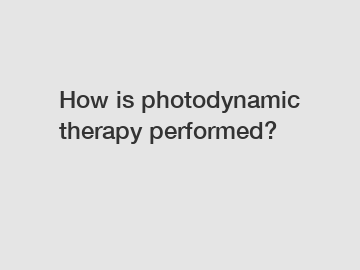How is photodynamic therapy performed?
How is photodynamic therapy performed? This innovative medical treatment involves the use of a photosensitizing agent and light to destroy targeted abnormal cells in the body. By answering this question, we can explore the origins of photodynamic therapy, its process, as well as its significance and impact on medical practice.
Photodynamic therapy (PDT) is performed by first administering a photosensitizing drug, such as aminolevulinic acid (ALA), into the patient's body. This drug selectively accumulates in the targeted abnormal cells, such as cancerous or precancerous cells. After a sufficient amount of time for the drug to accumulate, a specific wavelength of light is applied to the treatment area.
The interaction between the photosensitizing drug and the light leads to the production of reactive oxygen species (ROS) within the abnormal cells. These ROS cause damage to the cellular structures and ultimately induce cell death. Importantly, the adjacent healthy cells remain unaffected since they either do not accumulate the drug or are not exposed to the specific light wavelength.

The origins of photodynamic therapy can be traced back to the serendipitous discovery by researchers in the early 20th century. They observed that certain dyes could cause skin lesions when exposed to light. This observation led to the recognition that light could be utilized to selectively destroy abnormal cells. Over the years, the understanding of the underlying mechanisms and the development of more potent photosensitizing agents have significantly improved the effectiveness of photodynamic therapy.
The effectiveness of PDT has been demonstrated in the treatment of various conditions, including certain types of cancer, skin disorders, and age-related macular degeneration. For instance, in the field of oncology, PDT offers a less invasive treatment option compared to traditional surgery or radiation therapy. It can be used to target specific areas and minimize damage to surrounding healthy tissues. Additionally, PDT can be repeated multiple times if necessary, making it a valuable tool in the management of localized cancers.
Moreover, photodynamic therapy has potential implications in the field of antimicrobial treatments. Studies have shown that PDT can be effective against drug-resistant bacteria, fungi, and viruses. This alternative approach to combat microbial infections could help reduce the reliance on antibiotics and mitigate the issue of antibiotic resistance.
In summary, photodynamic therapy is performed by administering a photosensitizing agent and applying a specific wavelength of light to targeted abnormal cells. This treatment modality was originally discovered through the observation of dye-induced skin lesions and has since evolved into a highly effective and versatile medical technique. PDT has proven its efficacy in various medical fields, offering less invasive treatment options and showing potential in antimicrobial therapies. As research continues to advance, photodynamic therapy may hold even greater promise in the future.
If you want to learn more, please visit our website Laser Diode Machine, Laser Diode Machine, Sincoheren.

Comments
0